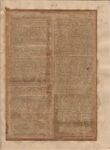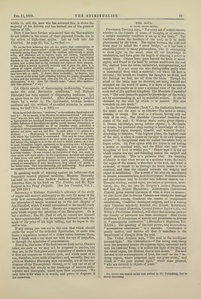HPB-SB-4-213: Difference between revisions
mNo edit summary |
mNo edit summary |
||
| (One intermediate revision by the same user not shown) | |||
| Line 60: | Line 60: | ||
{{HPB-SB-footer-footnotes}} | {{HPB-SB-footer-footnotes}} | ||
{{HPB-SB-footer-sources}} | |||
<gallery widths=300px heights=300px> | <gallery widths=300px heights=300px> | ||
london_spiritualist_n.286_1878-02-15.pdf|page=7|London Spiritualist, No. 286, February 15, 1878, p. 77 | london_spiritualist_n.286_1878-02-15.pdf|page=7|London Spiritualist, No. 286, February 15, 1878, p. 77 | ||
</gallery> | </gallery> | ||
Latest revision as of 06:08, 8 October 2024

Legend
< Theosophy Simplified (continued from page 4-212) >
wields it, and the man who has achieved this is above the majority of his fellows, and has learned, one of the greatest lessons of life.
Then it has been further mis-stated that the Theosophists do not believe in the return of their departed friends, nor in the action of high-class spirits. Let us look into Isis Unveiled, At page 67, Vol. L, we find:—
We are far from believing that all the spirits that communicate at I circles are of the classes called “elemental” and “elementary.” Many, especially among those who control the medium subjectively to speak, write, and otherwise act in various ways, are human, disembodied spirits. Whether the majority of such spirits are good or bad, largely depends on the private morality of the medium, much on the circle present, and a great deal on the intensity and object of their purpose. If this object is merely to gratify curiosity and to pass the time, it is useless to expect anything serious. . . . One of the most powerful attractions of our departed ones is their strong affection for those whom they have left on earth. It draws them irresistibly, by degrees, into the current of the astral light vibrating between the person sympathetic to them and the universal soul, (See also Vol. II. p. 593, “The greatest philosophers,” et seq. Also, Col. Olcott’s letter, “about other mediumship than physical,” et seq.)
Col. Olcott speaks of discouraging mediumship, “except under the most favourable conditions,” and Madame Blavatsky has been accused of disparaging mediums. Let us again turn to Isis Unveiled, After discussing a parallel drawn by. a writer in The Spiritualist, between modern mediums and the workers of so-called miracles in ancient times, we find (Vol. I., p. 486):—
Were these God-like men “mediums,” as the orthodox Spiritualist will have it? By no means, if by the term we understand those “sick-sensitives” who are born with a peculiar organisation, and who, in proportion as their powers are developed become more and more subject to the irresistible influence of miscellaneous spirits, purely human, elementary, or elemental. Unquestionably so, if we consider every individual a medium in whose mesmeric atmosphere the denizens of higher invisible spheres can move, and act, and live. In such sense every person is a medium….. Mediumship is measured by the quality of the aura with which the individual is surrounded. This may be dense, cloudy, noisome, mephitic, nauseating to the pure spirit, and attract only those foul beings who delight in it, as the eel does in turbid waters; or it may be pure, crystalline, limpid, opalescent as the morning dew. All depends upon the moral character of the medium. About such men as Apollonius, Iamblichus, Plotinus, and Porphyry, there gathered this heavenly nimbus. It was evolved by the power of their own souls in close union with their spirits; by the superhuman morality and sanctity of their lives, and aided by frequent interior ecstatic contemplation, Such holy men pure spiritual influences could approach. Radiating around an atmosphere of pure beneficence, they caused evil spirits to flee before them. This is mediatorship, not mediumship. Such persons are temples in which dwells the spirit of the living God.
In speaking words of warning against the influences that frequently control physical mediums, Madame Blavatsky has said no more than Andrew Jackson Davis, the great American Seer, in his book on The Diakka, and Mr. Epes Sargent in his Proof Palpable. (See Isis Unveiled, Vol. I., pp. 218-220.)
Returning to Madame Blavatsky’s advocacy of the study of magic and ancient philosophy as the cure for many of the evils now surrounding mediums and mediumship, we find the principles of magic summed up in the last chapter of Isis Unveiled, which I would recommend to the careful study of all readers of that book. Herein are comprised the subjects which engage the attention of the Theosophist. He is but a student; like St. Paul of old, he counts not himself to have apprehended; but he stretches forward towards the mark of the prize of his high calling, and he hopes in the end to win.
If any among you can see in this aim that which should excite the anger of the orthodox Spiritualist, or make him desire a separation instead of a closer union between them, then I think such a one must see with the eye of prejudice, or through the spectacles of prepossession.
True it is, that some of the doctrines set forth in Col. Olcott’s letter, are such as we may not be prepared to receive, but they are, in the first place mostly expository of matters which it does not concern us to decide upon, and which most of us can, therefore, leave aside altogether; and, secondly, they are given as Madame Blavatsky says repeatedly, not as the conclusions of the Theosophical Society, or of any one or all of its members, but simply as the teachings of ancient philosophers and theurgists, based upon their experience. We may take it for what it is worth, and prove or disprove it for ourselves.
The Soul
Professor Tyndall says, “For every act of consciousness, whether in the domain of sense, of thought, or of emotion, a certain molecular condition is set up in the brain.” The condition shows the bondage of the soul, as it is made phenomenal by the brain. The region between the soul and brain may be called the “asses’ bridge,” as it has been a stumbling-block to many philosophers, who in attempting to show light on the mind, trace all our knowledge to cerebration, and have gone the length of denying a priori or innate ideas. Others have gone beyond the brain or mind region, and found in the head by intense meditation the real life, distinct from the brain, immaterial, unimpressional, and tranquil. It is not every one who distinguishes easily what is immaterial from what is material; our whole life here is material; the breath we breathe, the thoughts we think, and the feelings we feel, are all from the brain. Though the, mind or the brain may be elevated, yet being limited and intended for the world of sense, it is more or less sensuous, and does not enable us to take a spiritual view of the soul of souls and of His spiritual kingdom. The Mundaka Upanishad says, “The soul cannot be gained by knowledge (of the veda), not by understanding it, not by manifold science. It can be obtained by the soul by which it is desired. His soul revealeth its own truth.”
In the Srimutt Bhaqabat (Book V.), the distinction between the mind and the soul is as follows—The mind is awake, dreams, or sleeps. The soul is a witness, having only one state of its own. The Mundaka Upanishad describes four states of the soul: 1. Waking state, seeing gross objects; 2. Dream knowledge, seeing subtler objects; 3. No desire, no dream, but profound sleep ending in knowledge of God; 4. Spiritual state, tranquil, blissful, and without duality. According to Sanedra, “the highest place, the highest state of the soul, is when it exists as the soul in its own inherent nature.” In the spiritual state we realise the subtle body or lingua serira. St. Paul agrees with the Aryas in our having a subtle or spiritual body, and the Bible also says “the Kingdom of God is within you.” Fichte says it is the ego which creates non ego, and Scheiling makes the subject and object identical. This is a pedantic idea. Its meaning evidently is that when we are in a spiritual state, the mind, the organ of the senses, is absorbed in the soul, and what is external, or comes to us through the brain, ceases to be so received, and thus the identity between the subject and object is established. The powers of the soul are manifested in dreams, somnambulism, and clairvoyance. Somnambulism and clairvoyance may be divided into different classes, viz.: Thought-reading, second-sight, prediction or prevision, introvision, &c., &c., &c. (see Dr. Gregory’s Animal Magnetism, and Lee on Animal Magnetism). Abercrombie (Intellectual Powers) gives several instances of what is done in dreams; we also know that in dreams Cabanis saw clearly the bearings of political events, Condirect the results of complicated calculations, Condillac developed subjects, and in a waking state Carnotte minutely foretold the French Revolution. Forbes’ Oriental Memories, Colonel Duerow Taylor’s life, and Wilby’s Predictions Realised, show that in some persons the faculty of prevision has been developed. Miss Cobbe attributes all revelations of secrets and predictions in dreams to “unconscious cerebration” {Macmillan's Magazine, Vol. XXIII.) The ignoring of the soul power, and substituting “unconscious cerebration” is a mistake. Cerebration is purely matter, and derives all that it manifests in the department of thought from the soul.
The Vrihat Arayana says, “The soul is the intelligent internal light.” The Chhandazza—“The living soul, rising from the corporeal attains the supreme light, and comes forth with his identical form, it is neither the light of the sun, nor the visual organ, but Brahma that is here meant.” The soul devoted to the contemplation of God, fits itself for the “undying region, where perpetual light and glory abide,” and which is “the pure eternal light,” where none proceed, “who are devoted to objects of sense.”
Calcutta, January 17th, 1878.
Dr. Slade was unwell on his first arrival in St. Peterburg, but is slowly recovering.
Editor's notes
- ↑ The Soul by Mittra, Peary Chand, London Spiritualist, No. 286, February 15, 1878, p. 77
Sources
-
London Spiritualist, No. 286, February 15, 1878, p. 77

